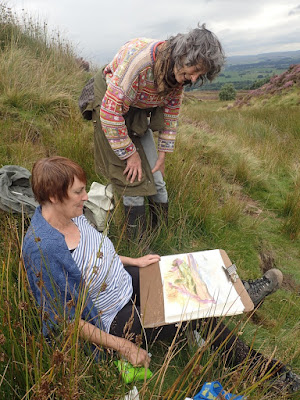There's more to Yorkshire Moorland Ecology than Hats and Ducks. A group of us set off on a small patch of moorland ten miles west of Ilkley Moor to find out. It is a day sponsored by North Yorkshire Open Studios.
We are led by artist Bridget Tempest who has the idea of linking art and all that goes on on moorland. She has enlisted the help of myself (botanist), Nancy (Landscape person), a team of neighbouring young explorers and four aspiring artists
We met at Rushbank on the side of Broughton/Elslack Moor.
We have our sketchpads ready. "Look for the big shapes. Divide the page up into the main shapes - maybe sky, background area and foreground. Look at the patch of rushes above us. What shape does it make?"
 |
| An excellent demonstration of dividing the paper into shapes - by B aged 5. And look, he's drawn Tufted Hair-grass in the foreground. |
Sue has brought water colours. Bridget gives positive feedback
The Heather is in full bloom
Before coming I have asked my friends in Craven Conservation Group "What animals we might find?"
"Oak Eggar Moth." they say.
Yes! We find one. - a male - and rather battered - but it is mid August.
"Yes! we find one.
Several in fact, clutching on to Rush and Wavy Hair-grass stems, waving in the wind.- and they do look very, very juicy. This one comes back down to the studio - but we release it afterwards.
We find Heather-Beetles, Grass-Moths, a frog, owl pellets and various droppings.. rabbit, sheep, grouse, pheasant?
In my earlier visit I had noticed how the soil under the heather was clearly marked in different layers:-
Black at the top
Bluey-whitey-grey
Black line on top of
Red 1 cm thick hard pan
Grey with occasional red mottling
Crumbly grey sand and clay and bed-material
Yes it is a podzol!!
And not a worm (or duck) in sight.
This is because the soil made by the dead heather leaves is too acid for bacteria. So too acid for the soil to rot down, so nothing for worms to eat. So the worms don't mix the soil up and the different layers remain clearly separated.
We measure the acidity of the soil with BDH Universal Soil Indicator and the solution goes bright red - indicating a pH of 4 (very acid)
When we get down to the track, surfaced with limestone chippings, the boys notice a molehill.
And in the molehill
- a big juicy worm!
We measure the pH of the Molehill - the chemical goes green this time - pH 7.5 Yes, this soil is basic (the opposite of acid). So bacteria grow on dead vegetation and the worms have something to eat.
The boys point to the worm in the molehill
Doris draws
I draw.
Come out with us if we go again next year
Up above the Dale in the purple moorland patch
Pop up a possy of people - Look at them - Watch
One is pulled up by a rope.. attached to straining dog
The second flings hands in air shrieking "Look, Look! a Frog!"
The third drops down from view, lost amonst the rushes
The fourth struggles on with wellingtons, through the boggiest of flushes
The fifths clambers ever upwards without a care or worry
through heather and cotton-grass and every type of berry (cran - bil - crow)
The sixth finds pellets from an owl and droppings from a grouse
And searches and searches for hole of vole or mouse.
The seventh has settled comfortably with sketchpad, paint and brush
The wind stops momentarily, there is a kind of hush
A red-thighed March-fly dangles precariously from an arching Hair-grass stem
Then flies off into space - No problem
Into space ...
That illusive cavity between interlocking spurs..
Above the hedge lined drumlins and the sycamores and firs
As far as Rye Loaf Hill and Ingleborough beyond
Up to the hanging clouds hanging clouds
hanging clouds.. hanging clouds..
to be finished at a later date.
........
Everything is interlinked.
Cycles.
Nitrogen
Special fungi around heather roots can fix atmospheric nitrogen and make it into "fertilizer".
Air > Mycorrhizal fungus > Heather > bee > honey > Human > sewage sludge > Agricultural fertilizer..
Actually honey only contains a very tiny amount of protein..
I'll have to think through this one again
I'll have to think through this one again
Nitrogen
Air (As N2) > Mycorrhizal fungus > Heather > Sheep > Human > sewage sludge > Agricultural fertilizer > Air (As NH3 or NO) > Klebsormidium crenulatum.
Kebsormidium is the velvety green alga we saw growing on the gritstone walls, that is growing more and more each year.
Nitrogen
Air > Mycorrhizal fungus > Heather > Heather Beetle > Meadow Pippit (or frog) > Owl > Owl Pellet >
Hey we live in a marvelous world!













No comments:
Post a Comment